
Palestine and Egypt

 |
Palestine and Egypt |
 |
The Carpathian Brigade in Palestine.
As mentioned above , the first Polish camp in Palestine was situated on the coast of Lake Tiberias (the place of Jesus Christ activity) on the subarb of the village called Samakh. Some more soldiers arrived there by Jugoslavia and Turkey to harbour in Haifa. Then the camp was moved to Latrun which was famous for its crusaders castle remains and the monastery of French Trapists monks. This monastery was situated on the hill nearby Emmaus, half way from Jerusalem to Tel-Aviv.
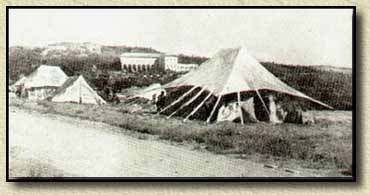
The camp in Latrun - in the background the famous monastery.
Polish Brigade was included to the group Palestine, Transjordan and Cyprus Forces which was in command of Scottish general A.R.Godwin-Austeen whose hedquaters were in Jerusalem. The Polish commanders prepared to exchange the equipment from French into British one and also started reorganizing the units according to British rules. Those changes were required as in the begining the Brigade was trained and suppoused to fight in mountain area but finally it was decided to survive and manage in the desert conditions. General Kopański postulated those changes on 20-th July 1940 and the British confirmed them on 5-th September 1940. According to this regulations the Brigade should consisted of 6199 soldiers including 294 officers. The new organization of units was difficult to achieve because of the lack of equipment . The British had a lot of equipment problems at the time so on 28-th July 1940 British commander of Middle East Force asked the Polish to give them 21 anti-tank guns which were brought from Syria. Finally during the stay in Latrun the Brigade didn't change neither its organization nor equipment. At last at the end of September it received the new British weapon and some received. The other reason of the state was the little number of warrant-officers as well as ordinary soldiers. On 7-th July so called Suplies Centre in Latrun was ordered to organize and the Concentration Post in Haifa belonged to it. One of its aims was completing and training new soldiers and also keeping their evidence. After the short period when new soldiers from Balcans stopped arriving, there was another one when they started coming again mainly through Turkey. When the Brigade left Palestine it consisted of 4568 soldiers including 311 officers.
The Carpathian Brigade in Egypt.
Just after the arrival to Palestine the possibility of using the Brigade in an offensive activity appeared according to the new situation in North Africa. After the Italian accession to war on 10-th June 1940 the serious danger appeared in the region of the Suez Canal not only from the south side but also from the west side of Libya. After the capitulation of France the Italians were much stronger in Libya and able to attack the British army in Egypt. Despite of the Italians strenght and the number of their soldiers the British who were weeker appeared as more active and more effective in this region. During the firts three months of war they defeated the Italians in many ways by kiling, injuring and imprisioning more than 3500 Italian soldiers and the British lost only 150. On 13 September 1940 marshal Rodolpho Graziani who substituted marshal Balbo (killed on 28-th June during his flight over Tobruk) decided to use the 10 Italian Army for the next attack of Egypt. As the result he started to occupy the seaside village Sidi Barrani and stoped at Mersa Matruh situated more than 200 km. east from borderline. At the same time from 1-st to 7-th October the Polish Brigade were moved by railway and the vehicles and partly by sea to the Egyptian Alexandria , where they had to organize a new camp in the area of settlement called Dikheila about 12 km. far from Alexandria. This way they managed to occupy the coastline as long as 10 km. The Brigade was indirectly under general H.M.Wilson the commander of the British forces in Egypt. They were many dangers of Italian air raids especially at so called 'full moon nights' . The main target was the harbour in Alexandria which was the base of British Navy in the region of the East Mediterraean Sea . The inhabitans were ucertain of their situation and so getting nervous livitg in a permanent fear. The local newspapers published the articles with the capital letter printing on their first pages 'Alexandria is protected by the Polish - there is no reason to panic'.
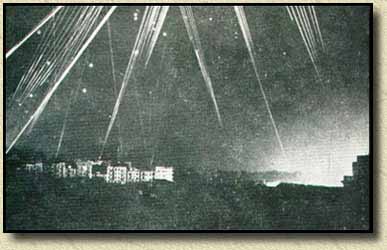
The night air raid of Alexandria.

The soldiers of Carpathian Brigade on the defense posts in the region of Dikheila near Alexandria in 1941.

The part of SBSK offensive route.
At the same time the Italians defeated the whole teritory of British Somalia and crossed the borders of Kenya and Sudan. Italian Air Force was still bombing not only Alexandria but also the Suez Canal region and military camps in the area of Cairo. During those air raids the brigade lost their first soldiers and parts of equipment. Despite the difficult situation on 9-th December 1849 general Wilson ,executing orders of general Wavell, began an offensive attack (operation 'Compas') which main aim was to save and protect the Nile delta. On 11-th December he rescued Sidi Barrani and went on west. During two months the British captured Bardia, Tobruk, Derna , El-Ghazala and the capital of Cyrenaica Benghazi reaching El-Agheila on the border of Tripolitania. As the result the whole Italian army consisted of 10 divisions was defeated. The British captured 130 000 captives, 400 tanks, 1240 guns having only 500 soldiers killed , 1355 injured and 55 lost. The Polish Brigade didn't take part in that rapid campaign because of shortage of vehicles, transporters and another armoured equimpent. From 13-th December 1940 Polish soldiers guarded the prisioner-of-war camps, supply squats and airports on the way from Alexandria to Tobruk. General Kopański was finally succeed in reorganizing the Brigade into the vehicled unit . After the formal British approval on 12-th 1941 general gave the organizing order. Polish unit become an Independent Brigade Group (in Polish - Samodzielna Brygada Strzelców Karpackich - S.B.S.K. ) with the planned number of soldiers - 5674 including 348 officers. According to this regulations this unit should have 893 vehicles of various type , 106 carriers (a kind of transporter ) and 217 motocycles. Unfortunately the whole reorganization took a long time because almost all of vehicles produced were sent directly to the units which were already involved in fighting. So the real depot of Polish Brigade was much more smaller. It consisted of 4573 soldiers , 359 officers , 37 vehicles , 54 motocycles. At the same time the Italian -Greek war broke out after the Italian offensive from already occupied Albania. Although there were the great number of Italian soldiers but because of hard winter conditions they weren't able to defeat couragerous Greeks in mountains. The Italians also started losing their power in Africa so Hitler decided to support them by German invasion in Balcans and Africa. In spring 1941 British authorities decided to establish an expedition corps of 100 000 soldiers - including Polish Brigade - from North Africa to support the fighting Greek. There were only 9-th Australian division and part of 2-nd British division left in Cyreneica. The Polish Brigade was ordered to join the expedition corps , but the British wanted to divide the Polish unit and include to the different British ones. Fortunately general Kopański objected to it consequently and finally was succeed because Brigade remain undivided. As early as 9-th March 1941 the British Near East headquaters decided to concentrate the whole Brigade in the region of Alexandria. On 28-th March another reorganization started on to get the unit ready to fight in mountains. Several hundred of horses and mules came back to the unit and one company from each infantry battalion had to be dismissed to take care of the animals. According to new rules the Brigade became almost the same type as previously in Syria.

The artilery of the Carpathian Brigade near Alexandria.

In Egypt - the squadron of Polish Lancers Regiment - the last cavaliery of Polish Forces.
The Carpathian Brigade (SBSK) - oganization scheme according to British rules- the most importrant was the new number of battalions 'three' instead of traditional 'two' regiments .
On 9-th April the artilery equipment and the supliee were loaded in Alexandria . The ship took its place in the convoy to Greece which was being formed at the enter of Alexandria port. During the time of its waiting the new order arrived. The convoy was stopped and the Brigade was ordered to come back to their concentration post. The reason was German invasion in Jugoslavia which had started since the night of 5-th April and Greece had been involved by Germans since 6-th April.
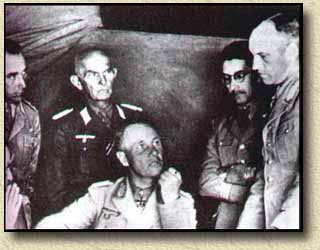
General Erwin Rommel -"Fox of the Desert"- in the XXI Italian Army Corps Headquaters.
At the same time the British commanders faced the danger of defeating their forces in Cyreneica. According to Hitler's decision taken on 3-rd February 1941 at the conference in Berchtesgaden , gen. Erwin Rommel and his headquaters landed in Tripolis on 12 -th February to support the Italians. He was in command of German expediction forces called Deutsche Afrika Korps . Rommel attacked El Agheila on 24-th March. Two Italian divisions 'Trento' and 'Ariete' supported the Germans. Rommel defeated the British in Cyreneica and on 7-th April 1941 invaded Derna. On 12-th April the Germans attacked Bardi almost reaching the Egyptian borderline and soon they managed to reach village Sollum in Egypt.
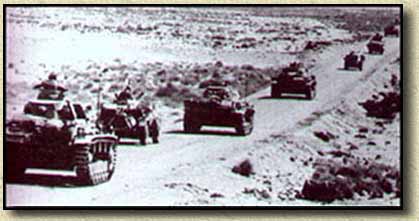
German-Italian tank unit folowing the British escaping towards Tobruk and Egypt.
As the result Tobruk was completly surrounded since 9-th April 1941 including 9 Australian division in command of general Morshead , a few artilery regiments and an uncompleted tank brigade. At the same time The Polish Brigade was evacuated back to well-known Dikhaila region near Alexandria. On 25-th May 1941 it was moved by railway transport to the desert fort Mersa Matruh 300 km far from Alexandria in order to rebuilt the south-eastern part of the deffensive line.
The Carpathian Brigade in Mersa Matruh.
The region of Mersa Matruh had been fortificated for a long time as one of the most importrant deffensive centres in Egypt. There were railway linem the road and the harbour. Those adventages created Mersa Matruh to the main supply centre of Libyan front as well as the first fort and concentration post for the desert units in case of an enemy attack. When the Polish Brigade arrived to Mersa Matruh where was 1-st South-African division which was in command of general G.E.Brink - the commander of the whole fortress. During their five-week stay they involved in many ways , rebuilding the fortress, training and securing the port and squats . All of the activities were tireing especially at that season of the year. The region in question was the main deffensive centre of Libyan front and it had still been bombed especially at nights from 9-th to 18-th June 1941. At the time mentioned on 16-th June durin the unsuccesful British attack on Halfaya the brigade lost their firs captives (from transport services). The last cavaliers of Polish Forces finally left their horses in Mersa Matruh and they received lorries and carriers instead. Syria was in danger of a German attack from Crete which had already been occupied , so Polish Brigade was considered as one of the units possible to take part in new conflict. However on 8-th June the British Army attacked Syria . Unexpectedly they faced French forces dependend on Vichy Goverment there so the regular s fight was started. The British decided to use the Polish Brigade to support their soldiers in Syria but general Sikorski objected as it could have caused a serious Polish-French conflict. At the end of June the whole Carpathian Brigade excluding the artilery was moved to the place called Sidi Baggush ( or Sidi Haneish as the railway station) which was situated 40 km east. The British Headquaters of Western Desert Forces were situated there as well. The conditions of live and work in Sidi Baggush were much more difficult than in Mersa Matruh especially during the hottest season (July-August) with sand storms called 'hamsin' accompanied by the lack of water and insects. During seven-week stay the fortifications were rebiult and an intensive training of units and their commanders was held. Several battalion exercises took place there in the desert conditions as well as four exercises in which nearly the whole Brigade was involved.
Machine-guns training in Sidi Haneish.
Desert exercises.
Sand storm 'hamsin' is coming.
There were also two day-night desert exercises with the complete vehicle equipment. The new course for carrier platoons and company commanders training were included to the wide education programme. The Brigade stayed in region of Sidi Baggush till the middle of August. On 17-th and 18-th August the units were concentrated again in camp El Amiriya near Alexandria . According to the decision of using the Brigade as a support of besieged Tobruk.
Through the desert.
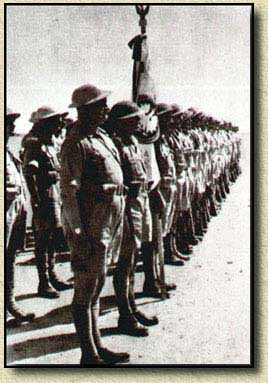
The standard attendance of the Carpathian Brigade on 24-th June 1941 in the Brigade Supply Centre in Latrun Palestine. The standard which was founded by the Polish refugees in Holly Land was also consecrated there. On 27-th July general Kopański handed it down to the standard-bearer in front of the deputies of Brigade units in Sidi Baggush.
Designed by: © P.Jaroszczak - Przemyśl 1999.